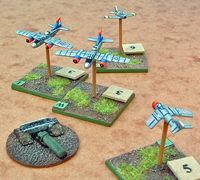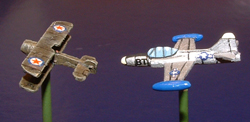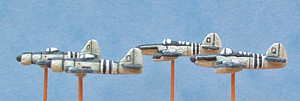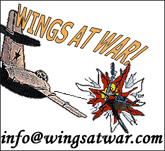The Korean War 1950-53
![]()
The end of the Second World War saw Japanese-held Korea divided into a Soviet controlled north and a US controlled south. Once the Soviet Union had equipped and trained their military forces the North Koreans stormed across the 38th Parallel in June of 1950 determined to unite the whole of Korea under Communist rule. The North Korean Air Force consisted of around 130 piston-engine planes including fighters, bombers and Shturmovik ground attack planes. By contrast the South Korean Air Force was made up of only sixty unarmed trainers as ironically the US was trying to avoid annoying the Communists by arming the South Koreans.
President Truman immediately ordered US Far East Forces to lend air and naval assistance, followed a few days later by US ground troops. With the small South Korean Army in full retreat, the only American units near enough to help were those based in Japan. Elements of the US 5th Air Force were quickly sent in to help stem the Communist attack. Prominent among the aircraft was the unique F-82 Twin Mustang, one of the few fighters with the range to strike from bases in Japan. An F-82 was the first to shoot down a Communist plane on the same day that B-26 medium bombers made their first bomb attacks.
With the arrival of aircraft carriers,
including HMS Triumph equipped with Seafires and Fireflys, and continuous
raids by B-29 Superfortress bombers in a tactical role, the Communist
invaders
 were stopped
just short of completely over-running the South.
were stopped
just short of completely over-running the South.
Counter-Attack
The United Nations soon organised itself and sent in a multi-national force, though the bulk of the effort was always American. Australian and South African Mustangs joined with USAF, US Marine and US Navy jets to sweep the North Korean Air Force from the Sky. Though Soviet piston-engined fighters were the equal of any propeller planes in the UN inventory they were completely outclassed by even semi-obsolete jets like the F-80 and F-84.
In mid-September US Marines landed at Inchon 20 miles west of Seoul and the beleaguered UN troops burst out of their tiny foothold at Pusan. In a dramatic reversal of fortune, assisted by 700 land-based and 300 carrier-based aircraft sorties per day, the UN sent the Communists scuttling back to the Yalu River - the border with Communist China.
The Chinese, fearing American influence so close to their border, began massing troops north of the Yalu. By late October, with the UN ignoring the warnings emanating from Beijing, 300,000 Chinese 'volunteers' infiltrated into North Korea. These smashed through UN lines precipitating a headlong rout back to the South.
There was a shock in store for UN pilots too. A patrol of USAF Mustangs caught sight of high flying silver machines north of the Yalu. The sun flashed on sharply swept wings as they banked into a steep dive and headed directly for the Americans. Within seconds the enemy jets shot through the American formation but superior experience and skill enabled the US pilots to manoeuvre an escape and the jets vanished back into China. The MiG-15 had arrived.
MiG Alley
The area in the north-west corner of Korea just to the south of the Yalu became known as MiG Alley. The major supply routes for the invading Chinese crossed the border and wound south to the North Korean capital of Pyongyang and beyond. This area was also the most heavily industrialised corner of North Korea.
UN planes were prevented from flying over China, as far as the UN Security Council was concerned China was neutral. MiG Alley therefore became the prime target for bomber missions, ranging fighter-bomber patrols and raids by carrier aircraft.
 The Americans
soon found their jets out-classed by the MiG-15. The latest US fighter;
the F-86 Sabre, till then tasked with protecting the US homeland
from nuclear bombers and keeping the Soviets at bay in Europe, was
loaded onto ships and rushed to Korea arriving in December 1950.
Days later four Sabres were cruising over MiG Alley when they spotted
four MiG-15s climbing towards them. The Sabres dived, pulled round
behind the startled Chinese, who expected their opponents to be
the rather more sedate US jets they normally encountered, and got
in behind the MiGs. The Chinese split up and headed back across
the Yalu. One didn't make it. Three 4-second bursts from the Sabre's
machine-guns sent it crashing 10 miles short of the Yalu.
The Americans
soon found their jets out-classed by the MiG-15. The latest US fighter;
the F-86 Sabre, till then tasked with protecting the US homeland
from nuclear bombers and keeping the Soviets at bay in Europe, was
loaded onto ships and rushed to Korea arriving in December 1950.
Days later four Sabres were cruising over MiG Alley when they spotted
four MiG-15s climbing towards them. The Sabres dived, pulled round
behind the startled Chinese, who expected their opponents to be
the rather more sedate US jets they normally encountered, and got
in behind the MiGs. The Chinese split up and headed back across
the Yalu. One didn't make it. Three 4-second bursts from the Sabre's
machine-guns sent it crashing 10 miles short of the Yalu.
Within a week the Chinese had their revenge when the first Sabre was lost to MiG cannon fire. On the same day eight F-86s tangled with fifteen MiGs shooting down six for no loss to the Sabres.
Honchos
The introduction of the F-86 enabled the UN to regain air superiority over MiG Alley. In May of 1951 Capt. James Jabara shot down his fifth MiG to become the first ever jet-jet ace. Soon UN pilots noticed a distinct increase in the skill level of their opponents. Along with Chinese and North Koreans they were now also facing Soviet, Czech and Polish pilots, many of them veterans of WW2, sent to China on three month combat tours. The Americans dubbed these new pilots 'Honchos' from the Japanese for boss.
The war on the ground settled into stalemate. The Communist Honchos went back to Europe and the UN regained total air superiority. With neither side able to see victory ahead a cease-fire was agreed in July 1953.
By then around 300 F-86s faced over 900
MiG-15s. However, the balance of pilot skill and confidence was overwhelmingly in favour of the UN.
Numbers are still disputed but Sabre pilots shot down more
than 800 enemy planes (twenty-seven piston fighters, nineteen bombers,
the rest being MiG-15s) for the loss of 78 of their own number.
Nearly 40% of the MiGs were shot down by the top 39 scoring
Sabre aces.
favour of the UN.
Numbers are still disputed but Sabre pilots shot down more
than 800 enemy planes (twenty-seven piston fighters, nineteen bombers,
the rest being MiG-15s) for the loss of 78 of their own number.
Nearly 40% of the MiGs were shot down by the top 39 scoring
Sabre aces.
Click on the links below for more information
